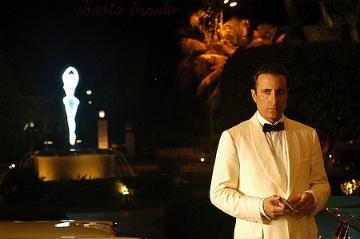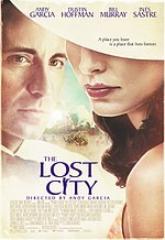
"Knight Thoughts" -- exclusive web content
Andy Garcia's directing debut is an ode to a Havana long gone and much missed
Cuban born actor Andy Garcia has spent 16 years trying to get his directorial effort, The Lost City, made. He’s finally done it and
the result is a beautiful yet somber eulogy for a bygone era that’s reminiscent of the French plantation sequence in Apocalypse Now
and The Garden of the Finzi-Continis. As an argument for a vibrant society that emphasizes the richness of culture, the arts and
education over the deadly earnestness of one steeped in rigid conformist politics, Garcia’s film is very convincing.
The movie is set in Havana, Cuba during the late 1950s. Garcia plays Fico, the eldest of three extremely handsome brothers, who is
the owner of the swanky El Tropico (based on the actual Tropicana) nightclub, which features spectacular nightly floorshows that were
the staple of glittering Havana during the lush era. As the movie opens, one of those lavish numbers plays out in the nightclub while
we meet Fico’s family – his two younger brothers and their wives as well as his revered parents and adored Uncle. Next we get a
closer look at the family during their regular Sunday dinner (“Not a minute after 6!” the father mock-warns). Fico’s father is an
instructor at the University of Havana, his mother a quiet force at his side (played by Millie Perkins who debuted as Anne Frank in
1959's The Diary of Anne Frank). As the dinner progresses it becomes obvious that an emphasis on culture and education have
played a large part in the upbringing of this family and already a forlorn nostalgia overwhelms the scene. Cuba is on the brink of
political change and both Luis and Ricardo, Fico’s younger brothers, are being swept up into different factions to protest against the
oppressive government (though they come to support different factions). Sadly, the days of wine & roses are about to end.
Much of what follows in the next section seems like an extended version of what was touched on in the Havana sequences of The
Godfather, Part II (Dustin Hoffman in fact appears as Meyer Lansky, the inspiration for the Hyman Roth character so memorably
played by Lee Strasberg in Godfather, Part II). Bill Murray plays an American writer and Fico’s good friend who seems to exist to walk
in at inopportune moments to comment on the surrounding action. Nevertheless, his inclusion lightens the film as it moves into very
heavy territory – though it’s never clear where Murray's character came from (or why he’s there to begin with). We track the eventual
exit of Batista with his excesses and corruption and the takeover of the country by Castro and his Marxist party followers. Also rather
quickly, Fico, who has remained apolitical and a devil may care playboy, finds that events have overtaken his family and his love
affair with his late brother’s wife, the gorgeous Aurora (Ineś Sastre). There are strong hints of The Mambo Kings in Fico’s doomed
relationship with Aurora which seems to be frozen in time even as it’s playing out. Eventually Fico is forced to flee the country to
begin life anew in America.
Though overlong, the sprawling film (shot in the Dominican Republic) is well acted (Garcia has a great cast to work with), looks terrific
(it’s shot in muted shades of black, green, blue and vivid white), and is underscored throughout with the beautiful Cuban songs that
add a great deal of feeling to the overall tone of the movie. Garcia's Fico never articulates his feelings but doesn't have to. His
haunted eyes -- especially in the final scene with his mother and father before leaving his country for the last time -- speaks louder
than words.
the result is a beautiful yet somber eulogy for a bygone era that’s reminiscent of the French plantation sequence in Apocalypse Now
and The Garden of the Finzi-Continis. As an argument for a vibrant society that emphasizes the richness of culture, the arts and
education over the deadly earnestness of one steeped in rigid conformist politics, Garcia’s film is very convincing.
The movie is set in Havana, Cuba during the late 1950s. Garcia plays Fico, the eldest of three extremely handsome brothers, who is
the owner of the swanky El Tropico (based on the actual Tropicana) nightclub, which features spectacular nightly floorshows that were
the staple of glittering Havana during the lush era. As the movie opens, one of those lavish numbers plays out in the nightclub while
we meet Fico’s family – his two younger brothers and their wives as well as his revered parents and adored Uncle. Next we get a
closer look at the family during their regular Sunday dinner (“Not a minute after 6!” the father mock-warns). Fico’s father is an
instructor at the University of Havana, his mother a quiet force at his side (played by Millie Perkins who debuted as Anne Frank in
1959's The Diary of Anne Frank). As the dinner progresses it becomes obvious that an emphasis on culture and education have
played a large part in the upbringing of this family and already a forlorn nostalgia overwhelms the scene. Cuba is on the brink of
political change and both Luis and Ricardo, Fico’s younger brothers, are being swept up into different factions to protest against the
oppressive government (though they come to support different factions). Sadly, the days of wine & roses are about to end.
Much of what follows in the next section seems like an extended version of what was touched on in the Havana sequences of The
Godfather, Part II (Dustin Hoffman in fact appears as Meyer Lansky, the inspiration for the Hyman Roth character so memorably
played by Lee Strasberg in Godfather, Part II). Bill Murray plays an American writer and Fico’s good friend who seems to exist to walk
in at inopportune moments to comment on the surrounding action. Nevertheless, his inclusion lightens the film as it moves into very
heavy territory – though it’s never clear where Murray's character came from (or why he’s there to begin with). We track the eventual
exit of Batista with his excesses and corruption and the takeover of the country by Castro and his Marxist party followers. Also rather
quickly, Fico, who has remained apolitical and a devil may care playboy, finds that events have overtaken his family and his love
affair with his late brother’s wife, the gorgeous Aurora (Ineś Sastre). There are strong hints of The Mambo Kings in Fico’s doomed
relationship with Aurora which seems to be frozen in time even as it’s playing out. Eventually Fico is forced to flee the country to
begin life anew in America.
Though overlong, the sprawling film (shot in the Dominican Republic) is well acted (Garcia has a great cast to work with), looks terrific
(it’s shot in muted shades of black, green, blue and vivid white), and is underscored throughout with the beautiful Cuban songs that
add a great deal of feeling to the overall tone of the movie. Garcia's Fico never articulates his feelings but doesn't have to. His
haunted eyes -- especially in the final scene with his mother and father before leaving his country for the last time -- speaks louder
than words.
I WAS Cuba:
The Lost City
5-12-06 "Knight Thoughts" web exclusive
By Richard Knight, Jr.
The Lost City
5-12-06 "Knight Thoughts" web exclusive
By Richard Knight, Jr.


